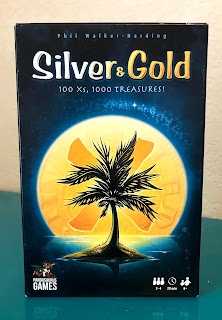5 Small Box Family Hits
Is there anything better than a family game night? Not too much. Just about every Sunday afternoon my household meets up with my brother's family for dinner and board games. Because of our child situation- six kids that range from ages three to ten- our focus can't entirely be on games with engrossing experiences.
While we do occasionally play a 90 minute or more game, as a general rule, small box games reign supreme. Here is a list of five family favorites.
But first an honorable mention: Silver and Gold.
This Phil Walker-Harding game has players exploring islands to find treasure, discover palm trees, and amass the most points. Simple rules and brisk playtimes have made this a popular game for our family.
Biggest Con- Even though there are several viable strategies to rack up the points, it can get a bit stale over repeat plays. To read my complete thoughts on Silver and God, click here.
And now the Top 5 (in alphabetical order)!
Coup-
Biggest Con- The take-that nature of the game has lead to moments where one player feels targeted. I have a blog about Coup if you're interested.
A Fake Artist Goes to New York-
To play the game, someone selects a category and chooses a specific word that the artists have to draw together one mark at a time. Here's the catch, one artist only knows the category and not the specific thing that is being drawn.
After the paper has gone around the table twice, the artists must simultaneously guess who the fake artist is. If they successfully identify the imposter of ink, he can still win if he can accurately guess what the drawing is. If not, the other players win.
This one was a surprise hit with us.
Biggest Cons- This game requires a minimum of five to play, and we seldom have that player count. It's also a little hard to grasp for new players.
Grifters-
On a player's turn, she can either play a card into the "Night 1" slot on her board to use the card's power, or she can play a team of cards that match an available job which will give her a one-time bonus and potentially help her with end-game scoring. How you utilize your cards is key because you won't get them back until they've passed through all three nights on your tableau. This hand management increases the strategy of the game.
Grifters ends when either all of the deck is claimed (which is unlikely), the bank runs out of money, or all of the jobs have been completed- whoever has the most money wins.
Biggest Con- There are a few cards whose power is definitely stronger than the others, and if you can string together some Femme Fatale and Protege cards back-to-back, that combo can be game-breaking.
Roll For It-
Players take turns rolling their dice and assigning them to whatever card or cards they want to. However, once the dice are placed down, they are locked in until one player matches all the dice and wins the card, or the player chooses to remove all of her dice from the cards on the table.
A player is victorious as soon as she scores 40 or more points.
Biggest Con- This is a true luck-fest. Whichever player is rolling the number on the face-up score cards will win. There is very little in the strategy department going on here.
Second Chance-
But he could still win. Once everyone is out, or the deck has been exhausted, the player with the least blank squares in his grid is the winner.
Biggest Cons- The provided pencils are entirely too small, and the yellow is practically invisible on the page. I laminated six sheets, and we use dry-erase markers instead. The shape cards, while good quality, are very difficult to shuffle.
Those are five (ok, six) of my family's favorite small box games. What small box games does your family love? Write them below in the comment section.













Comments
Post a Comment